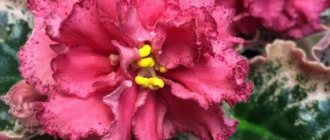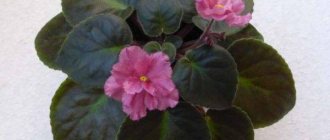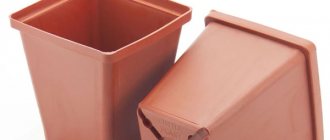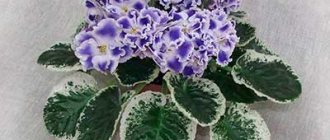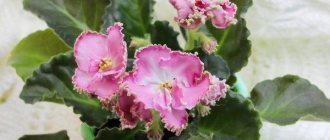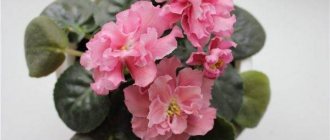Most representatives of the Saintpaulia genus live in the mountainous regions of East Africa . In Russia, this indoor plant appeared at the very beginning of the 20th century, and was the property of botanical gardens and private greenhouses.
The active selection of Uzambara violets in the USSR
began in the late 40s and early 50s of the last century. One of the founders of the theory and practice of developing new varieties of Saintpaulia was the married couple Boris Mikhailovich and Tatyana Nikolaevna Makuni.
Violet SM-Eternal May (Seedling Morev)
Genus, family
The variety belongs to the botanical genus Saintpaulia of the Gesneriaceae family.
History of the variety
The Eternal May variety was created by a talented Russian breeder, a student of Boris Makuni, Konstantin Morev. Programmer education allows you to: with mathematical precision:
- Calculate series of violet variability;
- And create varieties of rare beauty.
In his work, Konstantin chose several directions. Its varieties undergo strict selection , and only a few are presented to the viewer. Violets bred by Morev are characterized by:
- Variegation;
- Tricolor corollas;
- Green border on petals.
ATTENTION! The peculiarity of these varieties is the very long life span of each flower.
Photo and description of the variety
SM-Eternal May (seedling by K. Morev) - bright pansies collected in a dense bouquet. On the petals:
- Large bright scarlet or cherry spots;
- And emerald ruffle.
Sweet violet Eternal May.
Saintpaulia foliage
- Rich emerald color;
- The edge is serrated;
- The surface of the plate is quilted.
The leaves are collected in a symmetrical dense rosette .
The size of the corolla is average; for the “pansy” type this is a large modification .
Sports
The sport is characterized by leaves with:
- Wavy crenate edge;
- And a terry whisk.
This variety has sports.
Caring for a plant at home
Usambara violet is a common resident of our window sills . It is not difficult to care for her, the most important thing is:
- Attention;
- And an individual approach to each plant.
In order for violets to delight with abundant flowering and beautiful foliage, they need :
- Proper care;
- And under optimal conditions.
Proper watering and fertilizing
Water violets only when the top layer of soil in the pot has dried out . An individual approach is important here.
Different plants, depending on age, size, soil composition, size and material of the pot, need watering at different intervals. By watering all the plants in your collection at the same time, you risk:
- Fill some of them;
- And dry out others.
The water needs to sit for several hours.
ADVICE! For watering, use a watering can with a thin long spout or a syringe (50-100 ml in volume). A thin stream of water is directed to the edge of the pot, to the border with the substrate, making sure that the drops do not fall on the petioles and the growing point.
It is advisable to choose liquid fertilizers as fertilizers. They are easier to introduce. When adding additional food, follow the following rules :
- Nitrogen fertilizing is needed only during the period of green mass growth;
- Potassium and phosphorus stimulate long-lasting, abundant flowering;
- Microelements will help withstand unfavorable conditions;
- When choosing between fertilizing and replanting, choose replanting.
For the good health of Saintpaulia, fertilizing is necessary.
Lighting and temperature
Violets prefer bright but diffused sunlight on eastern and western windowsills .
In strong light, the rosette of the variety can become semi-mini , but the flowering does not become worse.
is not enough light :
- The leaves rise up;
- The rosette becomes like the blades of a helicopter rotor.
Air humidity
A resident of river banks, Saintpaulia, is very demanding in terms of maintenance :
- Moisture in the air;
- And the substrate.
These plants feel best at an air humidity of 50-60%. A healthy adult violet, with regular watering and optimal lighting, feels good at 40%.
What kind of soil does he prefer?
Based on the experience of flower growers, purchased soil for violets is rarely suitable. must contain .
Basic soil requirements for Saintpaulias:
- Moisture capacity;
- Air permeability;
- Sufficient content of potassium and phosphorus, nitrogen should not be in excess;
- Acidity 5.5-6.5;
- Favorable microflora;
- No pests or diseases.
You can collect soil for violets yourself.
to independently compiling a soil mixture for violets :
- An extremely simple substrate of high-moor peat and cultivators (vermiculite, perlite, charcoal). With this approach, the plants will need regular feeding;
- Preparation of a complex mixture balanced in chemical composition. When using it, fertilizing is practically not required.
Pruning and hygiene
An adult violet bush must be shaped. The foliage should overlap each other, like tiles on a roof. Peduncles form in the leaf axils . Therefore, without a healthy, strong rosette, active flowering cannot be achieved.
Usually the bush consists of 3-4 tiers of leaves . The lower ones begin to fade, turn pale, they are removed, just like:
- Empty flower stalks;
- Sick, damaged leaves.
ADVICE! As the bush grows and leaves are removed, the plant's stem becomes exposed; it needs to be sprinkled or buried when replanting.
Dust accumulating on the fluffy leaves of violets;
- Spoils the appearance;
- And it harms gas exchange.
A hygienic shower will help get rid of it . After protecting the soil with a film, rinse each leaf under a thin stream of warm water. After showering, be sure to let the plants dry in the shade.
Methods of propagation of the variety
Most often, Saintpaulia is propagated by leaves.
The variety reproduces well. The simplest ways :
- Leaf cuttings. You can root in water and in soil. Roots and children form very quickly;
- Kids. Eternal May is prone to the formation of children. They produce roots even faster than leaf cuttings.
Transplant rules, rejuvenation
Saintpaulias are replanted every 1.5-2 years . Remaining in the same soil longer, the plant stops blooming. The size of the pot can be left the same when replanting. The easiest time for the plant to undergo this procedure is in March.
The main task of replanting is to give the plant the opportunity to grow a young root system , which will give the plant strength to form strong leaves and flower stalks.
Transplantation is an excellent reason to rejuvenate the plant; it is carried out according to the following algorithm :
- The soil must be dried so as not to damage the roots during transplantation;
- Remove the root system, freeing it as much as possible from the compacted substrate;
- Remove old leaves that have lost their elasticity;
- If the violet is more than 2 years old, cut off the old roots;
- Place the roots in fresh soil, covering them up to the level of the leaves;
- After some time, when the soil settles from watering, you can fill it up.
IMPORTANT! It takes about a month for Saintpaulia to settle into new soil.
Care techniques in indoor culture
The seedling responds with gratitude to the attentive and careful implementation of the simplest agrotechnical measures and regimes :
- The plant should be placed on a window facing west or east; specimens from a window to the north are shown additional rays with a diffuse spectrum, to the south - an artificial shadow is required;
- Water in small doses from the moment when slight drying of the upper volume of the substrate appears. The seedling drinks more water than many Saintpaulias, so it should be watered more often;
- Apply additional fertilizing mineral fertilizers, focusing on the condition of the seedling bushes;
For good flowering of Saintpaulia, fertilizing is necessary. - Provide light primarily during the day, long-lasting, with a spectrum of scattered rays;
- Control a constant heat level within +20 + 24°C ; eliminate sudden fluctuations in the gradient;
- Plant in nutritious, permeable soil with good aeration; ensure the creation of a volumetric drainage layer;
- When transplanting , transshipment is often preferred if there are no special indications;
- humidity indicators using any possible methods, avoiding only direct spraying of the bushes themselves.
Features of flowering, growth and reproduction
Seedling Eternal May:
- Easy to care for;
- Growing and developing rapidly;
- Easy to reproduce.
The presented violet blooms magnificently under comfortable conditions.
Prefers natural light. When artificial, the corollas float pink.
How long does it take to grow an adult plant?
goes through several stages from a leaf cutting to an adult plant :
- Formation of roots on cuttings – 3-4 weeks;
- The appearance of babies is 5-6 weeks;
- Starter formation – 3 months;
- First flowering – 7-9 months.
How are varietal characteristics transmitted?
Eternal May reproduces willingly and produces many children .
Flowering in hot and cool conditions
This seedling variety produces flowering that matches the description at temperatures of 23-240C . In cooler conditions it produces lighter flowers and a brighter ruffle. In the heat there may be no ruffles at all.
What do flower stalks look like?
Violet flower stalks:
- Dense;
- Strong.
The flower stalks of the Eternal May violet are very strong.
They do not grow vertically, but somewhat obliquely.
Is it possible to achieve cap flowering?
Blooms profusely . Peduncles are collected in a bouquet of impressive size.
Bud lifespan
During the winter months, the variety blooms for about 5 weeks , then breaks for 4 weeks, and blooms again. From spring to autumn, new flowers appear constantly.
Eternal May, Lunar Shine, Raspberry Ale (K. Moreva varieties)
Good afternoon, dear violet lovers! I would like to present to you the flowering of violets selected by Konstantin Morev from my collection.
Violet Eternal May. Description: large white pansies with a scarlet spot on each petal and a green fringe:
Let me tell you that I fell in love with this variety immediately and absolutely! He exudes such touching tenderness and defenselessness, as well as truly artistic ugliness. My Eternal May often tries to bloom as he pleases. During the observation process, it became clear that this seedling variety blooms as described in warm conditions. Reacts to temperature - cooler - it brightens, warmer - the spots are where they should be. Now let's look at the portraits of flowers:
Scarlet, or I would say bright cherry spots (scarlet spots are less common on my flowers) are often located in a chaotic order. It feels as if the artist carelessly brushed a brush over a bush of flowers:
It often happens that a violet flower appears almost entirely dark scarlet:
Green fringe is always present:
Flowers of completely different colors can open on one rosette! I think that the coolness from the winter window and the heat from the radiators are to blame for this - flows of air of different temperatures greatly affect the color when buds are laid.
Konstantin Morev provided us with an extremely amazing seedling variety! In the photo, the flower turned out like this and lay on its side:
Extremely beautiful violet Eternal May! Every flowering is a surprise! In the photo, in my opinion, he even tried to smear himself:
Flowers brighten in cool weather:
And the flowers become sort of milky white, that is, not snow-white, but like creamy white completely or with light pink spots - that’s how I would describe it - and with a green fringe. The beauty is simply breathtaking!
In sufficient light, the rosette of this variety sometimes tends to become semi-mini and is very sensitive to light, but this does not affect the quality of flowering at all. Peduncles are strong, but often grow obliquely. I would not say that the flowers are large, but medium in size. That is why the flowers of this violet look so trusting, naive, I would say. If there were larger flowers, I wouldn’t have such feelings of modesty and defenselessness of this violet.
My violet Eternal May is my favorite!
The seedling variety Eternal May is completely unpretentious, reproduces willingly, has many children, and grows quickly. Beautiful scarlet spots appear on the petals at moderately warm temperatures. In winter it blooms in waves - it blooms for more than a month, then rests for a month. And with the onset of spring it blooms constantly. I love my violet very much!
The next seedling variety from Morev is Moonlight Glitter. Description: A large white double star with dark blue-violet or lilac markings on each petal.
Medium size socket. This variety of violet likes to drink water; you need to carefully monitor the drying of the soil:
I wouldn’t say that there are prints on the petals—more like white flashes:
It blooms long and profusely, on one peduncle there can be up to 4 flowers, and under the weight the peduncles bent and the flowers lay on the leaves:
Having matured a little, the cap began to bloom:
A very beautiful variety for lovers of terry pompom balls:
Apart from the peculiarities of watering, I consider this variety to be completely unpretentious. It reproduces easily and grows quickly. In winter, it blooms on the shelf in waves; this seedling variety needs very moderate coolness. When it’s hot, it turns completely blue; at low temperatures, really white flowers appear, but with pale lilac prints. Personally, I am satisfied with the flowering shown in the photo, these flashes of white, like reflections. A very beautiful seedling variety.
And the last seedling variety from Morev is Raspberry Ale. I must say that the presence of this variety puzzled me - on the Internet at that time - at the time of purchasing the leaf - there was no information about it at all. Well, almost none - only on one forum I came across a description of the variety without a photograph; I only had a memory of the color of the violet from which the leaf was purchased. The collections of other violet lovers and catalogs posted on the Internet did not include this variety. I don’t know now - maybe more information has appeared. Oh well, okay. And now the description - bright crimson semi-double stars with a wide ruffled pink-cream border:
The rosette from which I took the sheet actually had a pink-cream border, but it turned out dark, barely noticeable:
In the light from the window, the border is more noticeable:
It turned out to be a very interesting seedling:
He even hesitated:
Compact rosette, cheerful flowers:
There were difficulties with reproduction; I didn’t want to take root in water. I noticed that the majority of Morevsky varieties prefer to take root and produce babies in the ground and in a greenhouse, well, maybe that’s just how it works for me.
Of course, there are many varieties of violets similar to him, but no one has yet canceled the attractiveness of Konstantin Morev’s creations!
Easy care. Blooms profusely and in waves. Cheerful shaggy flowers!
Thanks everyone for your attention!
